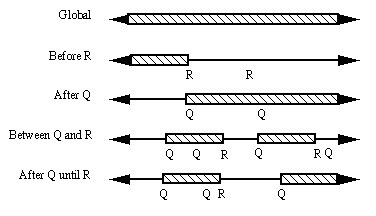
Figure: Pattern Scopes

Each pattern has a scope, which is the extent of the program execution over which the pattern must hold. There are five basic kinds of scopes: global (the entire program execution), before (the execution up to a given state/event), after (the execution after a given state/event), between (any part of the execution from one given state/event to another given state/event) and after-until (like between but the designated part of the execution continues even if the second state/event does not occur). The scope is determined by specifying a starting and an ending state/event for the pattern: the scope consists of all states/events beginning with the starting state/event and up to but not including the ending state/event.
The figure above illustrates the portions of an execution that are designated by the different kinds of scopes. We note that a scope itself should be interpreted as optional; if the scope delimiters are not present in an execution then the specification will be true.
Before and after scopes for our patterns are interpreted relative to the first occurrence of the designated state/event. We have done this because it matches our experience with real specifications. Note, however, that we could just as easily interpret these scopes relative to the last occurrence of the designated state/event (the mappings given in the patterns are easily transformed to match this interpretation). At present we do not see the need for supporting both first and last occurrence scopes, but as we gain experience applying the patterns we may wish to extend scopes in this way.
Scope operators are not present in most specification formalisms (interval logics are an exception). Nevertheless, our experience strongly indicates that most informal requirements are specified as properties of program executions or segments of program executions. Thus a pattern system for properties should mirror this view to enhance usability.